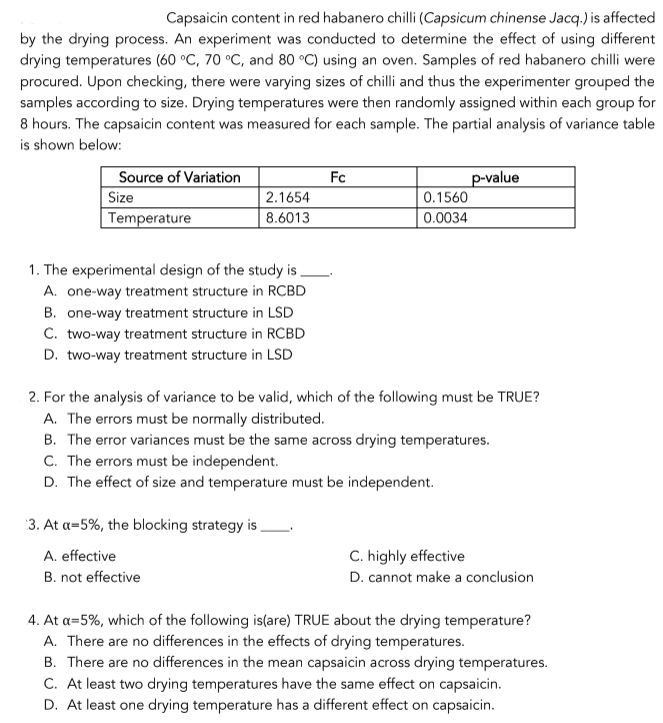Capsaicin content in red habanero chilli (Capsicum chinense Jacq.) is affected by the drying process. An experiment was conducted to determine the effect of using different drying temperatures (60 °C, 70 °C, and 80 °C) using an oven. Samples of red habanero chilli were procured. Upon checking, there were varying sizes of chilli and thus the experimenter grouped the samples according to size. Drying temperatures were then randomly assigned within each group for 8 hours. The capsaicin content was measured for each sample. The partial analysis of variance table is shown below:
Capsaicin content in red habanero chilli (Capsicum chinense Jacq.) is affected by the drying process. An experiment was conducted to determine the effect of using different drying temperatures (60 °C, 70 °C, and 80 °C) using an oven. Samples of red habanero chilli were procured. Upon checking, there were varying sizes of chilli and thus the experimenter grouped the samples according to size. Drying temperatures were then randomly assigned within each group for 8 hours. The capsaicin content was measured for each sample. The partial analysis of variance table is shown below:
Holt Mcdougal Larson Pre-algebra: Student Edition 2012
1st Edition
ISBN:9780547587776
Author:HOLT MCDOUGAL
Publisher:HOLT MCDOUGAL
Chapter11: Data Analysis And Probability
Section: Chapter Questions
Problem 8CR
Related questions
Question
Choose the correct answer for the subquestions of the sample problem below

Transcribed Image Text:Capsaicin content in red habanero chilli (Capsicum chinense Jacq.) is affected
by the drying process. An experiment was conducted to determine the effect of using different
drying temperatures (60 °C, 70 °C, and 80 °C) using an oven. Samples of red habanero chilli were
procured. Upon checking, there were varying sizes of chilli and thus the experimenter grouped the
samples according to size. Drying temperatures were then randomly assigned within each group for
8 hours. The capsaicin content was measured for each sample. The partial analysis of variance table
is shown below:
Source of Variation
Size
Temperature
Fc
p-value
0.1560
2.1654
8.6013
0.0034
1. The experimental design of the study is
A. one-way treatment structure in RCBD
B. one-way treatment structure in LSD
C. two-way treatment structure in RCBD
D. two-way treatment structure in LSD
2. For the analysis of variance to be valid, which of the following must be TRUE?
A. The errors must be normally distributed.
B. The error variances must be the same across drying temperatures.
C. The errors must be independent.
D. The effect of size and temperature must be independent.
3. At a=5%, the blocking strategy is,
A. effective
C. highly effective
B. not effective
D. cannot make a conclusion
4. At a=5%, which of the following is(are) TRUE about the drying temperature?
A. There are no differences in the effects of drying temperatures.
B. There are no differences in the mean capsaicin across drying temperatures.
C. At least two drying temperatures have the same effect on capsaicin.
D. At least one drying temperature has a different effect on capsaicin.
Expert Solution
This question has been solved!
Explore an expertly crafted, step-by-step solution for a thorough understanding of key concepts.
Step by step
Solved in 3 steps

Recommended textbooks for you

Holt Mcdougal Larson Pre-algebra: Student Edition…
Algebra
ISBN:
9780547587776
Author:
HOLT MCDOUGAL
Publisher:
HOLT MCDOUGAL

College Algebra (MindTap Course List)
Algebra
ISBN:
9781305652231
Author:
R. David Gustafson, Jeff Hughes
Publisher:
Cengage Learning

Holt Mcdougal Larson Pre-algebra: Student Edition…
Algebra
ISBN:
9780547587776
Author:
HOLT MCDOUGAL
Publisher:
HOLT MCDOUGAL

College Algebra (MindTap Course List)
Algebra
ISBN:
9781305652231
Author:
R. David Gustafson, Jeff Hughes
Publisher:
Cengage Learning